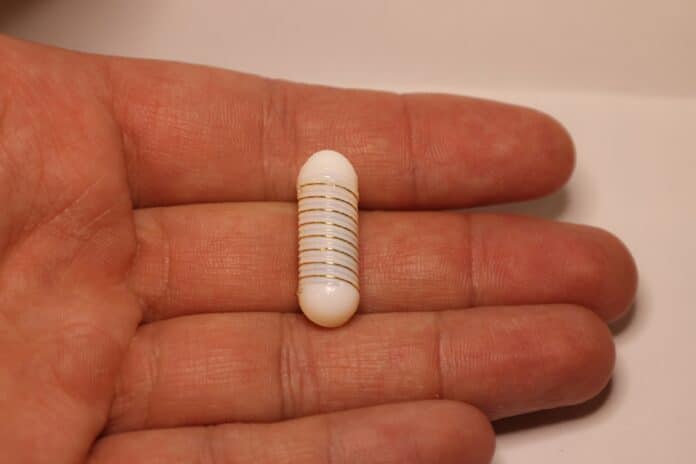A wide range of physiological processes, from nutrition to emotional behavior, are known to be regulated by the gut-brain axis, which is mediated by enteric and central neurohormonal signaling.
This axis is modulated using a variety of medications and surgical procedures, including motility agents and bariatric surgery. However, these methods expose patients to significant risks and are linked to off-target consequences or post-procedure recovery time.
MIT researchers have demonstrated that using an ingestible capsule that provides an electrical current to the cells, they can activate endocrine cells in the stomach to create ghrelin. This method could effectively treat disorders characterized by nausea or loss of appetite, such as cachexia.
Animal experiments conducted by the researchers revealed that this “electroceutical” capsule could significantly boost the stomach’s production of ghrelin. This method could be modified to offer electrical stimulation to other GI tract regions.
Giovanni Traverso, an associate professor of mechanical engineering at MIT, a gastroenterologist at Brigham and Women’s Hospital, and the senior author of the study said, “This study helps establish electrical stimulation by ingestible electroceuticals as a mode of triggering hormone release via the GI tract, We show one example of how we’re able to engage with the stomach mucosa and release hormones, and we anticipate that this could be used in other sites in the GI tract that we haven’t explored here.”
All aspects of digestion, including food movement through the GI tract, are controlled by the enteric nervous system.
Some patients with gastroparesis have reported symptomatic improvement after receiving electrical stimulation from a pacemaker-like device surgically implanted in the stomach.
Doctors hypothesized that the electrical stimulation would cause the stomach to contract, aiding food movement. However, it was later discovered that, while the treatment does help patients feel better, it has a lesser effect on motility.
Researchers hypothesized that electrical stimulation of the stomach would cause the release of ghrelin, which is known to boost hunger and reduce nausea.
To test this idea, they employed an electrical probe to give electrical stimulation in the stomachs of animals. They discovered that ghrelin levels in the bloodstream were significantly higher after 20 minutes of stimulation.
They also discovered that electrical stimulation had no significant inflammatory or adverse effects.
When the researchers discovered that electrical stimulation caused ghrelin release, they explored if they could do the same thing with a device that could be eaten and briefly remain in the stomach.
One of the most challenging aspects of constructing such a device is ensuring that the electrodes on the capsule can contact the fluid-coated stomach tissue.
The researchers gave their capsule a grooved surface that wicks liquids away from the electrodes to provide a drier surface with which electrodes can contact.
The surface they created was inspired by the skin of the Australian thorny devil lizard, which collects water using ridged scales. When the lizard touches the water with any part of its skin, water is transported to the lizard’s mouth via capillary action.
McRae said, “That inspired us to incorporate surface textures and patterns onto the outside of this capsule. That surface can manage the fluid that could potentially prevent the electrodes from touching the tissue in the stomach, so it can reliably deliver electrical stimulation.”
The capsule surface is made up of grooves that have a hydrophilic coating. These grooves act as channels, drawing fluid away from stomach tissue. Battery-powered electronics inside the device generate an electric current that flows across electrodes on the capsule’s surface.
According to the researchers, future versions of the prototype utilized in this study could be developed such that the current can be wirelessly turned on and off.
The researchers tested their capsule in the stomachs of large animals. They discovered that it produced a significant spike in ghrelin levels in the bloodstream, making it the first example of using electrical stimuli through an ingestible device to increase endogenous levels of hormones in the body, such as ghrelin.
Khalil Ramadi said, “As far as we know, this is the first example of using electrical stimuli through an ingestible device to increase endogenous levels of hormones in the body, like ghrelin. And so, it has this effect of utilizing the body’s systems rather than introducing external agents.”
The researchers discovered that the vagus nerve, which controls digestion, must be intact for this stimulation. The electrical pulses, they believe, are transmitted to the brain via the vagus nerve, where they trigger endocrine cells in the stomach to create ghrelin.
Within the next three years, the device will be tested on humans in Traverso’s lab as they investigate using this method in other portions of the GI tract. This treatment can potentially replace or supplement some current medications used to treat cachexia and anorexia, which reduce nausea and boost appetite.
The researcher said, “It’s a relatively simple device, so we believe it’s something that we can get into humans on a relatively quick time scale.”
The study was funded by the Koch Institute Support Grant from the National Cancer Institute, the National Institute for Diabetes.
Journal Reference:
- Ramadi, K. B., McRae, J. C., Selsing, et al. Bioinspired, ingestible electroceutical capsules for hunger-regulating hormone modulation. Science Robotics. DOI: 10.1126/scirobotics.ade9676
